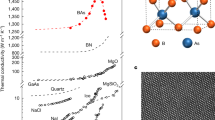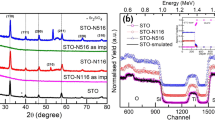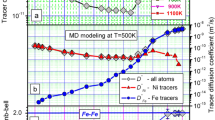Abstract
The most fundamental mass transport process in solids is self-diffusion. The motion of host-lattice (‘self-’) atoms in solids is mediated by point defects such as vacancies or interstitial atoms, whose formation and migration enthalpies determine the kinetics of this thermally activated process1,2. Self-diffusion studies also contribute to the understanding of the diffusion of impurities, and a quantitative understanding of self- and foreign-atom diffusion in semiconductors is central to the development of advanced electronic devices. In the past few years, self-diffusion studies have been performed successfully with isotopically controlled semiconductor heterostructures of germanium3, silicon4, gallium arsenide5,6 and gallium phosphide7. Self-diffusion studies with isotopically controlled GaAs and GaP have been restricted to Ga self-diffusion, as only Ga has two stable isotopes, 69Ga and 71Ga. Here we report self-diffusion studies with an isotopically controlled multilayer structure of crystalline GaSb. Two stable isotopes exist for both Ga and Sb, allowing the simultaneous study of diffusion on both sublattices. Our experiments show that near the melting temperature, Ga diffuses more rapidly than Sb by over three orders of magnitude. This surprisingly large difference in atomic mobility requires a physical explanation going beyond standard diffusion models. Combining our data for Ga and Sb diffusion with related results for foreign-atom diffusion in GaSb (refs 8, 9), we conclude that the unusually slow Sb diffusion in GaSb is a consequence of reactions between defects on the Ga and Sb sublattices, which suppress the defects that are required for Sb diffusion.
This is a preview of subscription content, access via your institution
Access options
Subscribe to this journal
Receive 51 print issues and online access
$199.00 per year
only $3.90 per issue
Buy this article
- Purchase on Springer Link
- Instant access to full article PDF
Prices may be subject to local taxes which are calculated during checkout


Similar content being viewed by others
References
Landolt-Börnstein, New Series, Group III , Vol. 26, Pt B, Diffusion in Solid Metals and Alloys (ed. Mehrer, H.) (Springer, Berlin, 1990).
Landolt-Börnstein, New Series, Group III , Vol. 33, Pt A Diffusion in Semiconductors (ed. Beke, D. L.) (Springer, Berlin, 1998).
Fuchs, H. D. et al.70Ge/ 74Ge isotope heterostructures: an approach to self-diffusion studies. Phys. Rev. B 51, 16817–16821 (1995).
Bracht, H., Haller, E. E. & Clark-Phelps, R. Silicon self-diffusion in isotope heterostructures. Phys. Rev. Lett. 81, 393– 396 (1998).
Wang, L. et al. Ga self-diffusion in GaAs isotope heterostructures. Phys. Rev. Lett. 76, 2342–2345 (1996).
Bracht, H., Norseng, M., Haller, E. E., Eberl, K. & Cardona, M. Enhanced and retarded Ga self-diffusion in Si and Be doped GaAs isotope heterostructures. Solid State Commun. 112, 301–314 ( 1999).
Wang, L. et al. Gallium self-diffusion in gallium phosphide. Appl. Phys. Lett. 70, 1831–1833 ( 1997).
Mathiot, D. & Edelin, G. Diffusion of indium in GaSb. Phil. Mag. A 41, 447–458 (1980).
Edelin, G. & Mathiot, D. A model for the determination of the defect concentrations in III-V compounds: The case of GaSb. Phil. Mag. A 42, 95–110 (1980).
Gude, A. & Mehrer, H. Diffusion in the D03-type intermetallic phase Fe3Si. Phil. Mag. A 76, 1–29 (1997).
Salamon, M. & Mehrer, H. Diffusion in the B20-type phase FeSi. Phil. Mag. A 79, 2137– 2155 (1999).
Bösker, G. et al. Arsenic diffusion in intrinsic gallium arsenide. Mater. Res. Soc. Symp. Proc. 527, 347– 356 (1998).
Weiler, D. & Mehrer, H. Self-diffusion of gallium and antimony in GaSb. Phil. Mag. A 49, 309– 325 (1984).
Tang, X.-P., Geyer, U., Busch, R., Johnson, W. L. & Wu, Y. Diffusion mechanisms in metallic supercooled liquids and glasses. Nature 402, 160– 162 (1999).
Talwar, D. N. & Ting, C. S. Tight-binding calculations for the electronic structure of isolated vacancies and impurities in III-V compound semiconductors. Phys. Rev. B 25, 2660– 2680 (1982).
Xu, H. Electronic structure of neutral and charged vacancies in Ga-related III-V compound semiconductors. J. Appl. Phys. 68, 4077– 4086 (1990).
Kühn, W., Strehlow, R. & Hanke, M. Self-consistent tight-binding investigation of chemical trends for native defects in III-V semiconductors. Phys. Status Solidi B 151, 541–557 ( 1987).
Walukiewicz, W. Mechanism of Fermi level stabilization in semiconductors. Phys. Rev. B 37, 4760–4763 ( 1988).
Walukiewicz, W. Amphoteric native defects in semiconductors. Appl. Phys. Lett. 54, 2094–2096 ( 1989).
Acknowledgements
H.B. acknowledges a Feodor Lynen fellowship from the Alexander von Humboldt-Stiftung. This work was supported in part by the Office of Energy Research, Office of Basic Energy Sciences, Materials Science Division of the US Department of Energy, and the US National Science Foundation.
Author information
Authors and Affiliations
Corresponding author
Rights and permissions
About this article
Cite this article
Bracht, H., Nicols, S., Walukiewicz, W. et al. Large disparity between gallium and antimony self-diffusion in gallium antimonide. Nature 408, 69–72 (2000). https://doi.org/10.1038/35040526
Received:
Accepted:
Issue Date:
DOI: https://doi.org/10.1038/35040526
This article is cited by
-
Thermal Annealing Effect on GaSb Thin Films Deposited on Si (001) for Assembly of GaSb/Mn Multilayer Systems at Room Temperature
Journal of Electronic Materials (2021)
-
Nonlinear compositional and morphological evolution of ion irradiated GaSb prior to nanostructure formation
Scientific Reports (2020)
-
GaZn-VZn acceptor complex defect in Ga-doped ZnO
Science China Physics, Mechanics & Astronomy (2018)
-
Performance improvement of highly mismatched GaSb layers on GaAs by interfacial-treatment-assisted chemical vapor deposition
Journal of Materials Science: Materials in Electronics (2017)
-
Influence of native defects on the infrared transmission of undoped Ga1−xInxSb bulk crystals
Journal of Electronic Materials (2005)
Comments
By submitting a comment you agree to abide by our Terms and Community Guidelines. If you find something abusive or that does not comply with our terms or guidelines please flag it as inappropriate.



